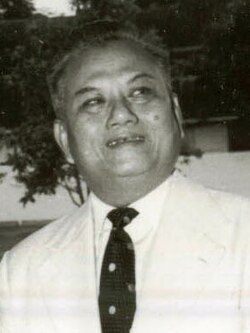Background and Representatives
The Three Princes represented three different political factions during the Laotian Civil War (1959–75), which was fought between the communist Pathet Lao (including many North Vietnamese of Lao ancestry) and the Royal Lao Government. Both sides received heavy external support in what became one of many proxy wars of the Cold War. It is known as the Secret War among the CIA Special Activities Division and Hmong veterans of the conflict. [2]
Prince Souvanna Phouma
Prince Souvanna Phouma was the leader of the neutralist faction and Prime Minister of Laos several times (1951–1954, 1956–1958, 1960, and 1962–1975). The Prince was supported by Kong Le and the Royal Lao Government.
Prince Souphanouvong
Prince Souphanouvong, unlike his half-brothers, was born to a commoner without royal lineage, Mom Kham Ouane. He was the figurehead president of Laos from December 1975 to August 1991. A staunch communist and the leader of the Pathet Lao, he was supported by Kaysone Phomvihane (later Prime Minister and President of the LPDR) and the North Vietnamese. By 1972, the Pathet Lao found it unacceptable to form a coalition with rightist members, mostly military generals and the rich and powerful Na Champassak and Sananikone families. [3]
This page is based on this
Wikipedia article Text is available under the
CC BY-SA 4.0 license; additional terms may apply.
Images, videos and audio are available under their respective licenses.




